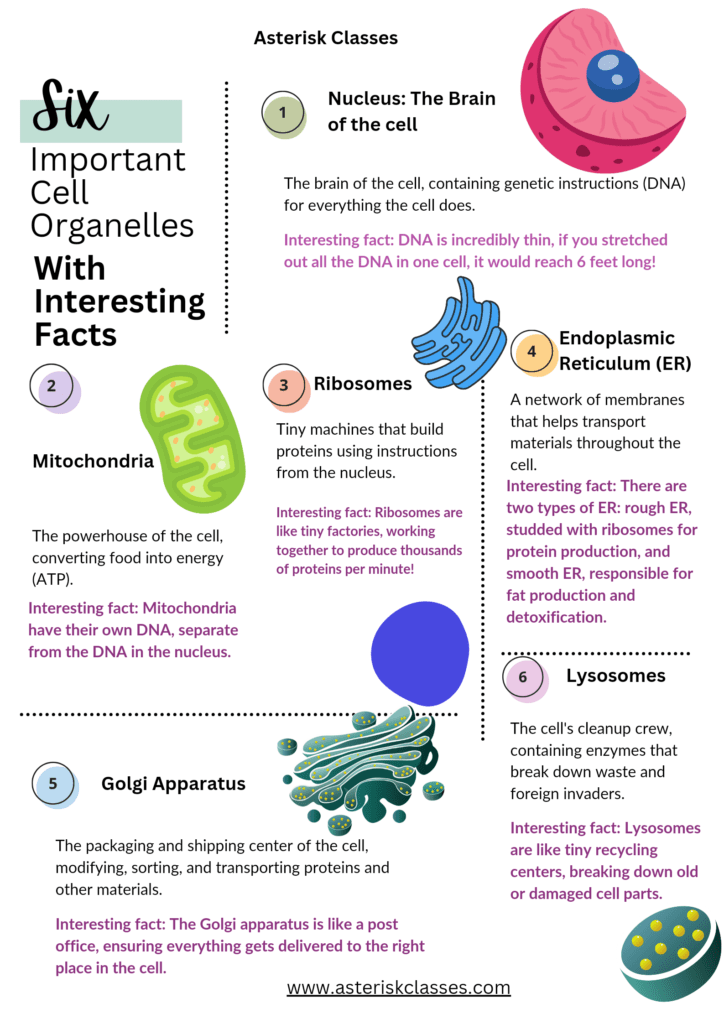
Exploring the Microscopic Marvels Organelles of Cells:
Fascinating Facts About Cell Organelles
Cells, the basic units of life, are fascinating microcosms that operate with remarkable precision and complexity. Within these microscopic entities, organelles play crucial roles, each contributing to the cell’s overall function. Here are some intriguing facts about these tiny yet mighty components of life.
1.The Nucleus: The Command Center : The nucleus is often referred to as the “brain” of the cell. It houses the cell’s genetic material and orchestrates activities such as growth, metabolism, and reproduction.
2. Mitochondria: The Powerhouses : Mitochondria are known as the powerhouses of the cell because they generate most of the cell’s supply of adenosine triphosphate (ATP), used as a source of chemical energy.
3. Ribosomes: The Protein Factories: Ribosomes are the sites of protein synthesis. These tiny structures are the assembly lines where amino acids are linked together to form proteins based on the instructions from DNA.
4. Endoplasmic Reticulum: The Production Line: The endoplasmic reticulum (ER) is a network of membranes that helps in the synthesis of lipids and proteins. The rough ER is studded with ribosomes, while the smooth ER is not.
5. Golgi Apparatus: The Shipping Department: The Golgi apparatus modifies, sorts, and packages proteins and lipids for delivery to targeted destinations within or outside the cell.
6. Lysosomes: The Recycling Bins: Lysosomes contain digestive enzymes that break down waste materials and cellular debris. They can be thought of as the cell’s recycling centers.
7. Vacuoles: The Storage Units: Vacuoles are large, sac-like structures that store nutrients, waste products, and other materials. In plant cells, they also maintain proper pressure within the cell to provide structure and support.
8. Chloroplasts: The Solar Panels: Found only in plant cells and some algae, chloroplasts are the sites of photosynthesis. They capture light energy and convert it into chemical energy in the form of glucose.
9. Cytoskeleton: The Framework: The cytoskeleton is a network of fibers that provides support, maintains cell shape, and facilitates movement through three main components: microfilaments, intermediate filaments, and microtubules.
10. Cell Membrane: The Security Gate: The cell membrane is a selectively permeable barrier that controls the movement of substances in and out of the cell. It’s composed of a lipid bilayer with embedded proteins.
11. Peroxisomes: The Detoxifiers: Peroxisomes contain enzymes that detoxify harmful substances, break down fatty acids, and contribute to the biosynthesis of important lipids.
12. Nucleolus: The Ribosome Producer: Located within the nucleus, the nucleolus is responsible for producing ribosomes. It assembles ribosomal RNA and proteins into ribosomal subunits.These organelles work in harmony to ensure the cell’s survival and function.
Understanding them not only provides insights into the complexity of life at the microscopic level but also underscores the intricate design of biological systems.